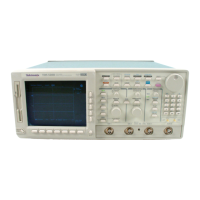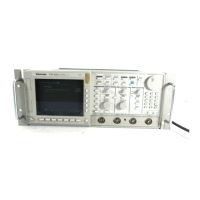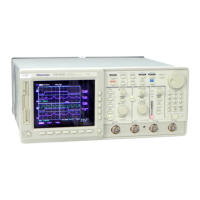TDS 340A, TDS 360 & TDS 380 User Manual
3–31
Using the FFT
Using the Fast Fourier Transform (FFT), you can transform a waveform from a
display of its amplitude against time to one that plots the amplitudes of the
various discrete frequencies the waveform contains. Use FFT math waveforms in
the following applications:
H Testing impulse response of filters and systems
H Measuring harmonic content and distortion in systems
H Characterizing noise in DC power supplies
H Analyzing vibration
H Analyzing harmonics in 50 and 60 Hz power lines
Description
The FFT computes and displays the frequency content of a waveform you
acquire as an FFT math waveform. This frequency domain waveform is based on
the following equation:
X(k) +
1
N
N
2
–1
n +
* N
2
x(n)e
–
j2nk
N
for : k + 0toN–1
Where: x(n) is a point in the time domain record data array
X(k) is a point in the frequency domain record data array
n is the index to the time domain data array
k is the index to the frequency domain data array
N is the FFT length
j is the square root of –1
The resulting waveform is a display of the magnitude of the various frequencies
the waveform contains with respect to those frequencies. For example, Fig-
ure 3–21 shows the non-transformed impulse response of a system in channel 1
at the top of the screen. The FFT-transformed magnitude appears in the math
waveform below the impulse. The horizontal scale for FFT math waveform is

